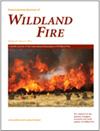<i>Corrigendum to</i>: Altered mixed-severity fire regime has homogenised montane forests of Jasper National Park
IF 2.9
3区 农林科学
Q1 FORESTRY
引用次数: 0
Abstract
Fire suppression has altered the historical mixed-severity fire regime and homogenised forest structures in Jasper National Park, Canada. We used dendrochronology to reconstruct fire history and assess forest dynamics at 29 sites in the montane forests. Based on fire scars and even-aged post-fire cohorts, we determined 18 sites had mixed-severity fire histories through time, and 11 sites had evidence of high-severity fires only – yielding a mixed-severity fire regime for the study area. Lodgepole pine, hybrid spruce and Douglas-fir established simultaneously after low- and high-severity fires. Regardless of fire history, forest canopies were mixed in composition and subcanopies were strongly dominated by shade-tolerant hybrid spruce. Despite their size, subcanopy trees were similar in age to the canopy trees. Current stand composition and age structures largely reflect the effects of high-severity fires that burned ~110 years ago at 18 of 29 sites. In the absence of fires after 1905, forests have matured simultaneously, homogenising the landscape and resulting in forest structures that are more conducive to high-severity fire than are fires of a range of severities. Proactive fire management is justified to restore fire as a vital ecological process and promote forest resilience by countering the effects of a century of fire suppression.<i>更正</i>:改变的混合严重程度的火灾制度使贾斯珀国家公园的山地森林同质化
灭火改变了加拿大贾斯珀国家公园历史上混合严重程度的火灾状态和均匀的森林结构。我们利用树木年代学方法重建了29个山地森林的火灾历史,并对森林动态进行了评估。根据火灾痕迹和年龄均匀的火灾后队列,我们确定18个地点具有混合严重程度的火灾历史,11个地点只有高严重程度火灾的证据–为研究区域产生混合严重程度的火灾制度。矮松、杂交云杉和道格拉斯冷杉在高低烈度火灾后同时生长。不论林火历史如何,森林冠层组成呈混合型,亚冠层以耐阴杂交云杉为主。尽管它们的大小不同,但亚冠树的年龄与冠层树相似。目前的林分组成和年龄结构在很大程度上反映了大约110年前在29个地点中的18个地点发生的高强度火灾的影响。在1905年以后没有火灾的情况下,森林同时成熟,使景观同质化,导致森林结构更有利于高严重程度的火灾,而不是一系列严重程度的火灾。积极主动的火灾管理是合理的,可以恢复火灾作为一个重要的生态过程,并通过抵消一个世纪以来灭火的影响来提高森林的复原力。
本文章由计算机程序翻译,如有差异,请以英文原文为准。
求助全文
约1分钟内获得全文
求助全文
来源期刊
CiteScore
5.50
自引率
9.70%
发文量
67
审稿时长
12-24 weeks
期刊介绍:
International Journal of Wildland Fire publishes new and significant articles that advance basic and applied research concerning wildland fire. Published papers aim to assist in the understanding of the basic principles of fire as a process, its ecological impact at the stand level and the landscape level, modelling fire and its effects, as well as presenting information on how to effectively and efficiently manage fire. The journal has an international perspective, since wildland fire plays a major social, economic and ecological role around the globe.
The International Journal of Wildland Fire is published on behalf of the International Association of Wildland Fire.

 求助内容:
求助内容: 应助结果提醒方式:
应助结果提醒方式:


